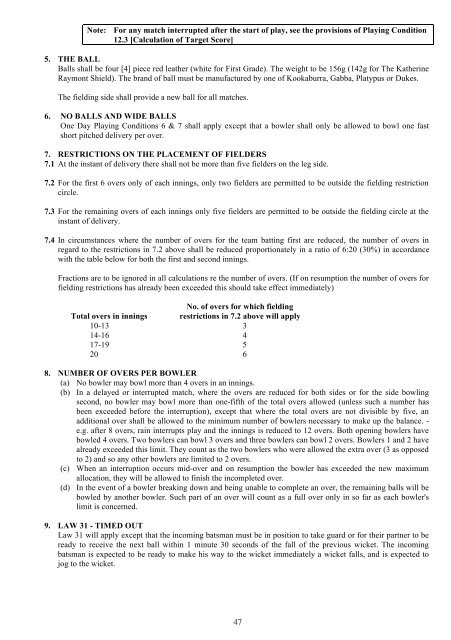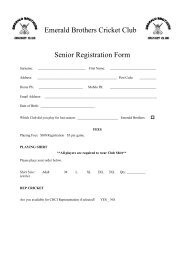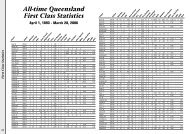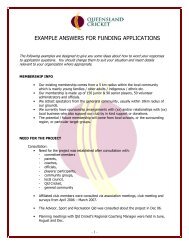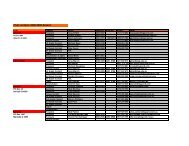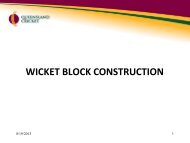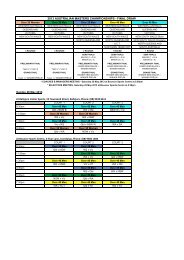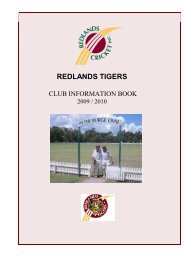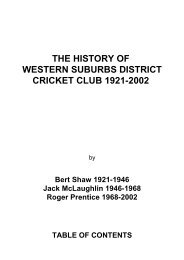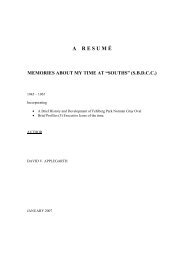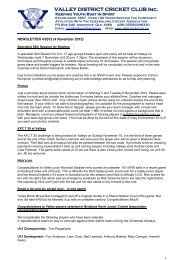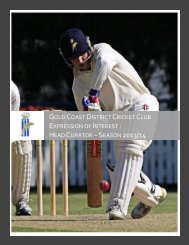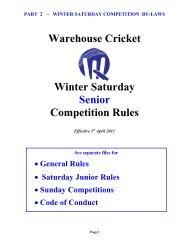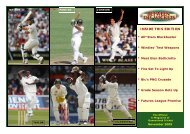2012 - 2013 PREMIER GR ADE HANDBOOK - Queensland Cricket
2012 - 2013 PREMIER GR ADE HANDBOOK - Queensland Cricket
2012 - 2013 PREMIER GR ADE HANDBOOK - Queensland Cricket
You also want an ePaper? Increase the reach of your titles
YUMPU automatically turns print PDFs into web optimized ePapers that Google loves.
Note: For any match interrupted after the start of play, see the provisions of Playing Condition<br />
12.3 [Calculation of Target Score]<br />
5. THE BALL<br />
Balls shall be four [4] piece red leather (white for First Grade). The weight to be 156g (142g for The Katherine<br />
Raymont Shield). The brand of ball must be manufactured by one of Kookaburra, Gabba, Platypus or Dukes.<br />
The fielding side shall provide a new ball for all matches.<br />
6. NO BALLS AND WIDE BALLS<br />
One Day Playing Conditions 6 & 7 shall apply except that a bowler shall only be allowed to bowl one fast<br />
short pitched delivery per over.<br />
7. RESTRICTIONS ON THE PLACEMENT OF FIELDERS<br />
7.1 At the instant of delivery there shall not be more than five fielders on the leg side.<br />
7.2 For the first 6 overs only of each innings, only two fielders are permitted to be outside the fielding restriction<br />
circle.<br />
7.3 For the remaining overs of each innings only five fielders are permitted to be outside the fielding circle at the<br />
instant of delivery.<br />
7.4 In circumstances where the number of overs for the team batting first are reduced, the number of overs in<br />
regard to the restrictions in 7.2 above shall be reduced proportionately in a ratio of 6:20 (30%) in accordance<br />
with the table below for both the first and second innings.<br />
Fractions are to be ignored in all calculations re the number of overs. (If on resumption the number of overs for<br />
fielding restrictions has already been exceeded this should take effect immediately)<br />
Total overs in innings<br />
No. of overs for which fielding<br />
restrictions in 7.2 above will apply<br />
10-13 3<br />
14-16 4<br />
17-19 5<br />
20 6<br />
8. NUMBER OF OVERS PER BOWLER<br />
(a) No bowler may bowl more than 4 overs in an innings.<br />
(b) In a delayed or interrupted match, where the overs are reduced for both sides or for the side bowling<br />
second, no bowler may bowl more than one-fifth of the total overs allowed (unless such a number has<br />
been exceeded before the interruption), except that where the total overs are not divisible by five, an<br />
additional over shall be allowed to the minimum number of bowlers necessary to make up the balance. -<br />
e.g. after 8 overs, rain interrupts play and the innings is reduced to 12 overs. Both opening bowlers have<br />
bowled 4 overs. Two bowlers can bowl 3 overs and three bowlers can bowl 2 overs. Bowlers 1 and 2 have<br />
already exceeded this limit. They count as the two bowlers who were allowed the extra over (3 as opposed<br />
to 2) and so any other bowlers are limited to 2 overs.<br />
(c) When an interruption occurs mid-over and on resumption the bowler has exceeded the new maximum<br />
allocation, they will be allowed to finish the incompleted over.<br />
(d) In the event of a bowler breaking down and being unable to complete an over, the remaining balls will be<br />
bowled by another bowler. Such part of an over will count as a full over only in so far as each bowler's<br />
limit is concerned.<br />
9. LAW 31 - TIMED OUT<br />
Law 31 will apply except that the incoming batsman must be in position to take guard or for their partner to be<br />
ready to receive the next ball within 1 minute 30 seconds of the fall of the previous wicket. The incoming<br />
batsman is expected to be ready to make his way to the wicket immediately a wicket falls, and is expected to<br />
jog to the wicket.<br />
47


